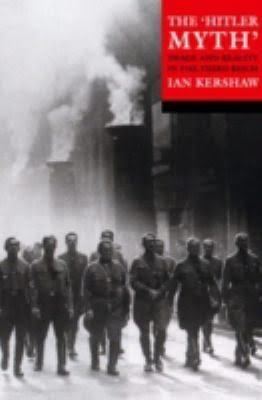7.8 /10 1 Votes
Country England Publication date December 13, 2001 | 3.9/5 Goodreads Language English Originally published 13 December 2001 | |||||||||||||||||||||||||||||||||
 | ||||||||||||||||||||||||||||||||||
Publisher Oxford University Press Similar Ian Kershaw books, Adolf Hitler books | ||||||||||||||||||||||||||||||||||
The "Hitler Myth": Image and Reality in the Third Reich (1987) is a book by historian Ian Kershaw.
Contents
Overview
In the book, Kershaw explores a concept he calls the "Hitler Myth" that describes two key points in Nazi ideology that depict Adolf Hitler as a demagogue figure and as a mighty defender. In the demagogue aspect Hitler is presented as a figure that embodies and shapes the German people, giving him a mandate to rule. As a defender, he is depicted as defending Germany against its enemies and redressing the imbalance imposed by the Treaty of Versailles. These were essential elements of propaganda of the time and helped to 'plaster over' early cracks in the Nazi Regime's facade, though by no means de-fusing all tensions in Germany at that time.
The myth of Hitler as the saviour of Germany from conspiracies directed against it by the Soviet Union and the West—especially France—was an extremely powerful tool in binding together the German people in loyalty and submission. The German people were left embittered by the ineffective and unstable party politics of Weimar Germany which had failed to rescue its people from the humiliation administered by Europe at the close of the First World War.
Thus, as Kershaw states,
"Hitler stood for at least some things they [German people] admired, and for many had become the symbol and embodiment of the national revival which the Third Reich had in many respects been perceived to accomplish."
The myth was lent much credence by Hitler's huge successes in the regeneration of Germany's economy over just a few years, recovering it from what seemed like unredeemable circumstances. In 1932, one year before Hitler's rise to power, unemployment had been at over five and a half million, but by 1938 Germany was producing at record levels, and unemployment was below 200,000 and real wages were up for the first time since authoritarianism.
According to Albert Speer, by around 1936 the Hitler Myth was under threat, with officials having to organise cheering crowds, presenting a stark contrast with Hitler's spontaneous crowds of old. The year 1938 saw a rise in Hitler's popularity, which dipped sharply with the outbreak of the Second World War. Only the victories in the West during 1940 revived it, and even then the campaign against the Soviet Union led to a dramatic decline in Hitler's popularity.
In his book Last Train from Berlin, Howard K. Smith wrote:
"I was convinced that of all the millions on whom the Hitler Myth had fastened itself, the most carried away was Adolf Hitler, himself."
Reception
The book was reviewed in The English Historical Review, European History Quarterly, and Journal of European Studies.
